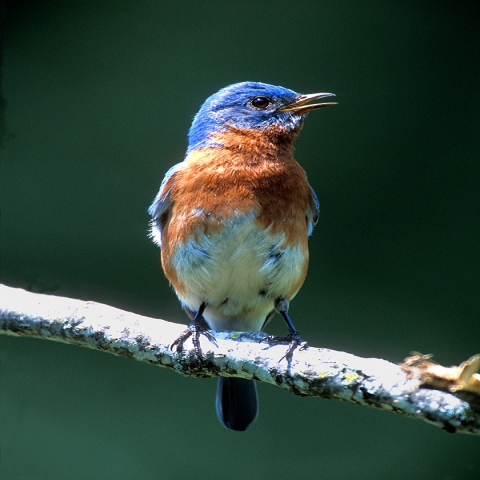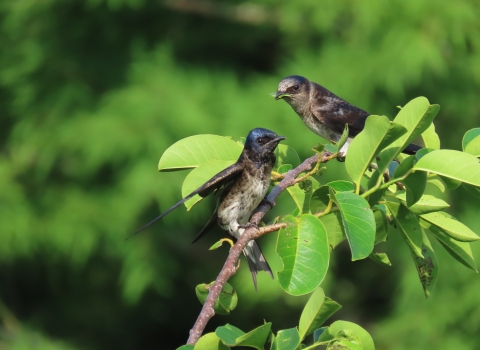On a pleasant Friday morning in Hartford, Connecticut, a crowd of residents, conservation partners, students and local officials gathered by the Keney Park Pond to celebrate the re-dedication of Hartford’s Urban Bird Treaty — a renewed commitment to improving the city as a place where both people and birds thrive.
People enjoyed small talk over coffee and croissants as they waited for the ceremony’s speakers to take the stage. But then, a ripple of excitement spread through the crowd, as an osprey swooped out from the woods beyond the water’s edge. The raptor circled above briefly before descending into a rapid nosedive towards the water’s surface.
Crash! In an instant, the bird hit the water and emerged with a healthy trout, then swiftly ascended back to the treetops to enjoy its well-earned catch. The crowd was rapt; In the middle of a city park, this was a spectacle — and a fitting introduction to the day’s event.
A new urban bird agenda
Our Urban Bird Treaty program is a national network that supports city partnerships to improve bird habitat in urban areas; reduce hazards to birds; and help residents, especially those in diverse and underserved communities, experience and learn about birds and the natural world. It engages residents in conservation, science, recreation and education. Hartford was named an Urban Bird Treaty city in 2011, making it the eighth city to receive the designation.
The treaty re-dedication ceremony at Keney Park set the stage for a new “urban bird agenda” for the Hartford partnership. In addition to the Service, partners in attendance included officials from the City of Hartford, Connecticut Audubon Society, Park Watershed and Friends of Keney Park.
At the event, Service Acting Deputy Regional Director Scott Kahan said: “Working in cities to conserve migratory birds is critical in so many ways; by restoring habitat and reducing hazards, we are not only benefitting birds and other wildlife, but also improving the health and well-being of families and children that live there. The City of Hartford is a shining example of how the Urban Bird Treaty program helps people recognize, enjoy, appreciate and protect migratory birds and other wildlife right in their community.”
Hartford might not be known as a top birding destination, but Keney Park visitors this year have seen an abundance: eastern bluebirds, red-tailed hawks, pileated woodpeckers and savannah sparrows, just to name a few.
Designed in the early 20th century by the renowned architectural firm Olmsted and Eliot, the park’s network of old forest, ponds and meadows makes it an ideal stop for migratory birds that travel along the Atlantic Flyway. With the support of the Urban Bird Treaty, partners in Hartford have restored vital bird habitat here and established a model for habitat improvement at other Hartford parks.
Additionally, partners have carried out native tree, shrub and flower plantings throughout the city, worked to remove trash and non-native invasive plants, and educated Hartford communities on important urban bird conservation issues like light pollution and building collisions.
Urban Bird Treaty Program National Coordinator Roxanne Bogart said: “Hartford’s Urban Bird Treaty partnership is creating important opportunities for people in diverse and underserved communities to engage in learning about and conserving local birds and their habitats, which improves the quality of life of birds, other wildlife, and people.”
Nature's classroom
Among the attendees were students from the Community First School – another Urban Bird Treaty partner – right across the street. The school’s students walk here at least once a week to engage in active, hands-on learning in nature — and, of course, to learn about birds.
“We often spend more time outdoors, on nice days like this, than we spend indoors,” said Timothy Goodwin, the school’s co-founder and principal.
Community First takes a place-based approach to education, tapping into Hartford’s existing resources — like Keney Park — to educate and strengthen students’ ties to the nature right in their own backyard.
From the edge of Keney Park Pond, the students watched as chimney swifts twittered and soared above, catching insects on the wing. Though highly common to urban areas, these birds are experiencing widespread decline in much of their range. They’re known as a “tipping point species,” which means they face the potential to become threatened or endangered. Urban habitat restoration and community education and engagement efforts are key to helping improve the chimney swift's chances.
“To know that [partners] are protecting the birds here is amazing because our kids love watching them so much,” said Goodwin.
Urban mosaic
After the re-dedication event, Mary Pelletier, director of both the nonprofit Park Watershed and Hartford’s Urban Bird Treaty partnership, led a few Service employees on a walk through Keney Park's trail. As we ventured farther into the forest, the trees seemed to grow even taller, and the bird songs more diverse.
In Mary’s eyes, cities are a mosaic — a confluence of nature, art, science, history and government — that carries unique potential for innovative conservation. She explained how creating a sustainable urban environment for people and wildlife is going to take everyone: teachers, artists, engineers, homeowners, students, scientists and historians. The Urban Bird Treaty program’s greatest strength is just that: it fosters a sense of inclusion.
“It’s about showing that everyone belongs and can contribute to this work. We need to focus on what we share rather than our differences. We all need clean water; we all need food. And the birds kind of embody that, too."




